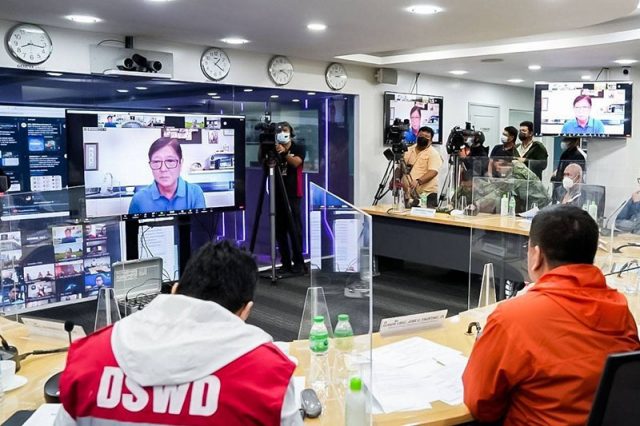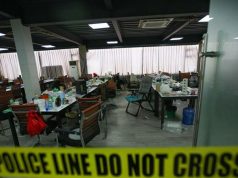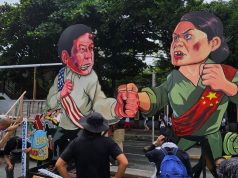
Filipinos online underscored the importance of a chief executive’s presence during natural calamities and disasters after individuals looking for the president were criticized on social media.
Former presidential spokesperson Harry Roque questioned those who are looking for and seeking updates about President Ferdinand Marcos Jr‘s whereabouts when Severe Tropical Storm Paeng (international: Nalgae) battered the country.
“Sa mga panahon po ng kalamidad na napakarami na ng namatay, nakakalungkot po na ang ilan sa atin pinupolitika pa rin ang sitwasyon…” he said on Tuesday.
“Bakit naman po pupunta sa gitna ng bagyo ang presidente? Para matangay ng hangin? Hindi po. Talagang pagdating sa management, bakit mo ilalagay sa aberya ang presidente?” Roque added.
“Hindi po dapat tinatanong nasaan ang presidente dahil ang presidente wala po ‘yan tulugan ‘pag merong ganitong aberya,” the former spokesperson of Marcos’ predecessor said.
The president amid crisis
The hashtag “#NasaanAngPangulo” trended when “Paeng” wreaked havoc on three main islands of the country in late October, unleashing destructive winds, torrential rains and deadly storm surges.
The tropical cyclone disrupted Filipinos’ long weekend plans and left at least 150 people dead in its wake. It also injured at least 128 individuals and caused 36 people to be missing.
“Paeng” also damaged infrastructures such as roads and severely damaged agricultural goods like high-value crops, livestock, poultry and fisheries.
On the day “Paeng” crossed Metro Manila and other surrounding provinces, Marcos made his presence known by presiding over a meeting of the National Disaster Risk Reduction and Management Council via Zoom.
Rumors swirled that he was in another country, Japan.
The next day, the Office of the Press Secretary denied the claims but remained mum on Marcos’ exact whereabouts.
By October 31, the chief executive conducted aerial inspections in some parts of the country to see and assess the damage left by “Paeng.”
Towards the end of a press briefing, Marcos, unprompted, quipped to the reporters, “Welcome to Hokkaido!”
His cheeky comment did not amuse some Pinoys who reminded the president that thousands suffered from the storm’s effects.
Roque later remarked that there was no need to ask about Marcos’ whereabouts, claiming it was a form of politicking.
This was denied by some social media users who argued that Marcos, as head of state, is expected to appear on top of the situation in such emergencies.
“Wala nagsasabi pumunta si Jr sa gitna ng bagyo. Gusto namin manguna [siya] sa paghahanda bago tumama ang bagyo. Hindi ‘yung hahanapin pa tapos lalabas sa Zoom meeting para manisi habang nasa kusina,” a Twitter user said in response to Roque’s post.
“A manager must always be there in case of incidents. They need to assess the situation, find the root cause, provide solutions, and expect feedback. They can delegate certain tasks but their presence is of prior importance,” another online user explained.
“Nobody on our side asked BBM to go in the middle of the storm to be washed away. Sa panahon ng kalamidad, [siya] ang una na dapat nasa frontline at mamuno sa coordination with NDRRMC,” wrote a different Pinoy.
“Wala namang nagpapapunta sa kanya sa gitna ng bagyo pero gustong malaman ng lahat na on top of the situation siya,” another Twitter user said.
“Kung yung MISMONG SINASALANTA na ng bagyo ang maghanap sa gobyerno, sa Pangulo… NAMUMULITIKA LANG BA SILA?” commented a different online user to Roque.
What experts say
Experts said that it is important for leaders to overcommunicate in times of crisis and to be “present” and “tangible.”
“What leaders really have to do in times of crisis is to over communicate. People in times of crisis are afraid. They’re anxious, they feel fear, they need to be reassured. In these times, it is very important for the leader to be present, to be there, to be tangible,” Professor Katharina Balazs of ESCP Business School said in a video.
“And even though leaders themselves often don’t know what exactly is going on, they need to give us much contextual information as possible to people. They need to address fears and anxieties and to prevent speculations and rumors, which very quickly come up when communication is not done,” she added.
A professor of leadership and organizational psychology said that leaders have to be proactive, especially in times of crisis.
“What leaders have to realize is that when a crisis hits, you can’t just rest on your laurels and think that everything will move along normally,” Ronaldo Riggio said in an interview.
“You need to train, prepare and execute,” he added.
“People want the leader to project compassion and an understanding of how the situation is for those concerned, and to project the hope that together we can manage the crisis, even though we don’t know everything about the present situation,” Ira Helsloot from Crisislab said in another interview.









